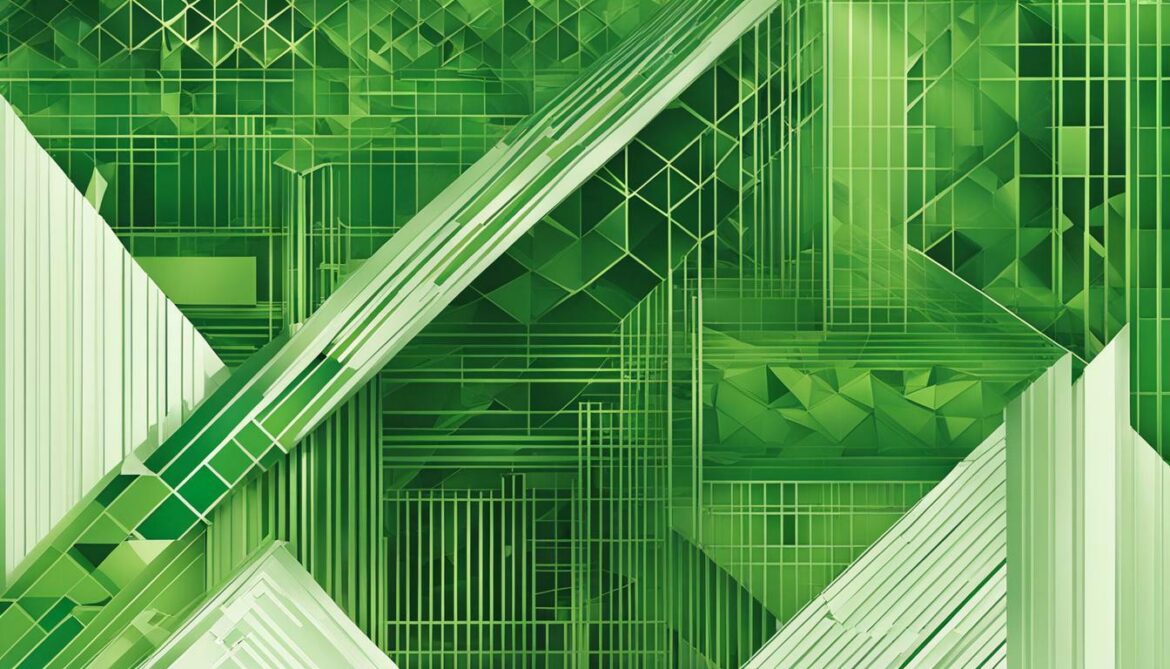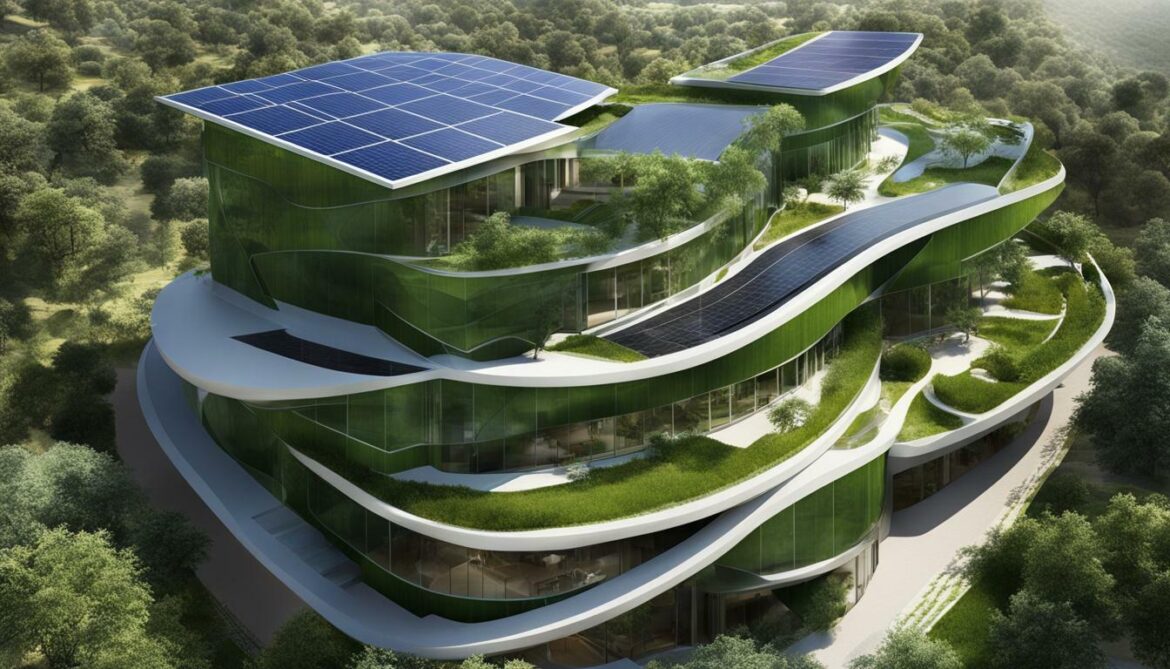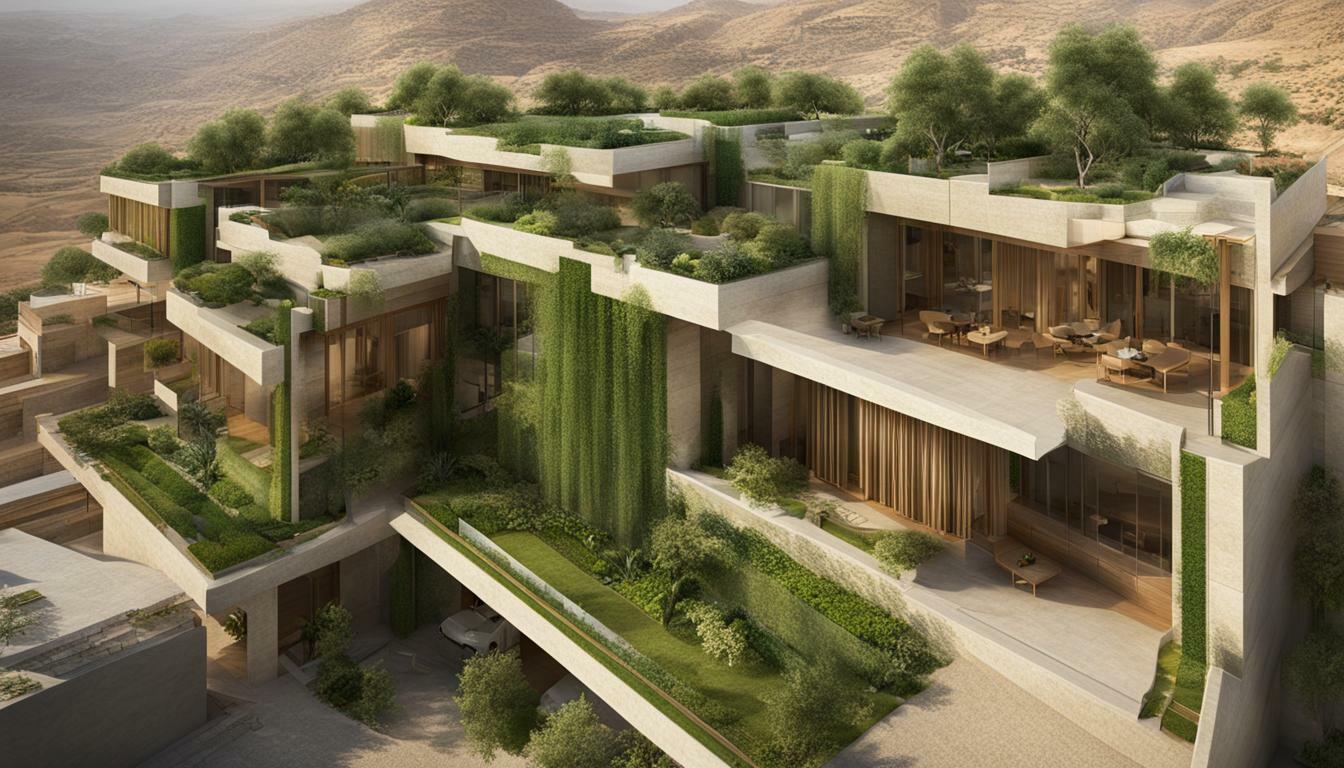Welcome to the fascinating journey of Jordan Green Building History, where sustainable architecture and eco-friendly construction practices have played a vital role in shaping the urban future of Jordan. This article will provide an overview of the history of green building in Jordan, highlighting the importance of sustainable architecture, eco-friendly construction, green building materials, energy-efficient design, and sustainable building practices.
- Jordan Green Building Council (Jordan GBC) is a non-governmental organization founded in 2009
- Efforts to develop green building practices started in 2009
- LEED registered buildings focus on energy consumption and implementation of local building codes
- The Jordan Green Building Guide (JGBG) was developed in 2013
- JGBG has four levels, allowing for an increase in Floor Area Ratio (FAR)
The Birth of Jordan Green Building Council
The Jordan Green Building Council (Jordan GBC), a renowned non-governmental organization founded in 2009, has been at the forefront of driving the adoption of Green Building Practices in Jordan’s construction industry. As a dedicated advocate, the Jordan GBC plays a crucial role in promoting sustainable building practices and raising awareness about the importance of environmentally-friendly construction.
Since its establishment, the Jordan Green Building Council has actively worked towards the integration of Green Building Practices in all phases of the building process in Jordan. With a focus on sustainability and eco-conscious design, the organization strives to create a greener and more energy-efficient built environment for the nation.

Through collaborations with various stakeholders including professionals, policymakers, and researchers, the Jordan GBC has successfully facilitated the development of green building practices in Jordan. By promoting the use of green building materials, energy-efficient technologies, and sustainable construction practices, the Jordan GBC contributes to the creation of a healthier and more sustainable built environment in the country.
Driving Change in Jordan’s Construction Industry
The Jordan Green Building Council’s efforts have been instrumental in driving change in Jordan’s construction industry. By establishing standards, developing rating systems, and providing guidance on sustainable building practices, the organization has created a framework for the adoption of green principles in the country.
The adoption of Green Building Practices not only enhances the energy efficiency of buildings but also improves the overall quality of life for the residents. By reducing the environmental impact of the built environment, the Jordan GBC’s initiatives contribute to creating a more sustainable future for Jordan.
| Key Achievements of the Jordan GBC |
| Establishment of green building standards and rating systems |
| Promotion of sustainable construction practices |
| Advocacy for the use of green building materials and energy-efficient technologies |
| Collaboration with stakeholders to drive sustainable urban development |
The Jordan Green Building Council continues to play a crucial role in shaping Jordan’s green building industry. Through its initiatives, the organization inspires and enables the construction industry to embrace sustainable practices, contributing to a greener and more resilient future for Jordan.
Development of a Rating System
In order to tackle energy and water demand and create a healthier environment, a rating system was developed in 2009, serving as a framework for green building practices in Jordan, resulting in the construction of numerous LEED registered buildings and the implementation of local building codes focused on energy conservation.
The rating system aimed to promote sustainable architectural design and construction practices that prioritize environmental responsibility. By encouraging the use of energy-efficient materials and technologies, it has contributed to the reduction of energy consumption and greenhouse gas emissions in Jordan’s building sector.

This comprehensive rating system considers various aspects of a building’s sustainability, including energy efficiency, water conservation, waste management, indoor air quality, and the use of renewable energy sources. By setting measurable criteria and providing guidelines for sustainable building practices, it has played a crucial role in shaping Jordan’s green building industry.
The rating system has also led to the development of local building codes that prioritize energy conservation. These codes ensure that new construction projects adhere to sustainable design principles, fostering a culture of environmentally-conscious building practices across the country.
Overall, the development of a rating system for green buildings in Jordan has significantly contributed to the promotion and adoption of sustainable architectural design and construction practices. It has paved the way for the construction of energy-efficient buildings, reduced environmental impact, and created a healthier and more sustainable built environment.
Introduction of the Jordan Green Building Guide
In 2013, the Jordan Green Building Guide (JGBG) was introduced, revolutionizing the way green buildings are assessed and incentivized in Jordan. This comprehensive guide provides a framework for sustainable urban development, promoting environmentally-friendly construction practices and renewable energy solutions. The JGBG is managed by the Greater Amman Municipality’s Green Building Unit, ensuring that registered buildings adhere to the highest standards of sustainability.
One of the key features of the JGBG is its rating system, which categorizes buildings into four levels based on their green credentials. These levels allow for an increase in Floor Area Ratio (FAR), providing incentives for developers to incorporate sustainable design principles into their projects. By following the guidelines set forth in the JGBG, architects and builders can create structures that minimize environmental impact and maximize energy efficiency.
The Greater Amman Municipality’s Green Building Unit plays a vital role in overseeing the implementation of the JGBG. With their expertise in sustainable urban development, they ensure that registered buildings meet the specified criteria for green building practices. By working closely with developers, architects, and contractors, they help promote a culture of sustainability in Jordan’s construction industry.

The introduction of the Jordan Green Building Guide has had a significant impact on the country’s built environment. It has sparked a wave of innovation and creativity, leading to the adoption of new green building concepts and construction materials. Additionally, the JGBG has encouraged the integration of sustainable energy technologies, further reducing the carbon footprint of buildings in Jordan.
The Jordan Green Building Guide and the efforts of the Greater Amman Municipality’s Green Building Unit are key drivers of sustainable urban development in Jordan. By promoting environmentally-friendly buildings and incentivizing the use of renewable energy solutions, they are contributing to a greener, healthier, and more resilient future for the country.
Energy Efficiency Codes in Jordan
Jordan’s commitment to energy efficiency in buildings is evident through the implementation of the Jordan Thermal Insulation Code and the Jordan Energy Efficient Building Codes, which have significantly enhanced energy efficiency in the country’s construction industry. These codes aim to reduce energy consumption, promote sustainable practices, and create a greener built environment.
The Jordan Thermal Insulation Code sets standards for thermal performance in buildings, ensuring that they are properly insulated to minimize heat transfer and reduce energy demand for heating and cooling. This code focuses on improving the building envelope, including walls, roofs, and windows, to enhance thermal insulation and prevent energy loss.
Similarly, the Jordan Energy Efficient Building Codes establish guidelines for energy-efficient design and construction practices. These codes cover various aspects of building energy consumption, including lighting, HVAC systems, and renewable energy integration. By adhering to these codes, developers and architects are encouraged to incorporate energy-efficient technologies and strategies, such as efficient lighting fixtures, proper insulation, and the use of renewable energy sources.

“The implementation of the Jordan Thermal Insulation Code and the Jordan Energy Efficient Building Codes has transformed the construction industry in Jordan,” says Ahmad Al-Hammouri, an architect specializing in sustainable design.
“These codes have not only reduced our reliance on fossil fuels but have also created a more comfortable and energy-efficient living environment for building occupants. They have paved the way for the integration of green building practices and have put Jordan on the map as a leader in energy-efficient construction.”
The Impact of Energy Efficiency Codes
The introduction of energy efficiency codes in Jordan has had a significant impact on the country’s building sector and its broader sustainability goals. Buildings constructed in compliance with these codes have experienced substantial energy savings, contributing to a reduction in greenhouse gas emissions and a more sustainable urban environment. Additionally, the adoption of energy-efficient practices has helped Jordan to mitigate the effects of climate change, improve indoor air quality, and reduce energy costs for building owners and occupants.
| Key Benefits of Energy Efficiency Codes in Jordan |
| 1. Reduction in energy consumption and greenhouse gas emissions |
| 2. Improved indoor comfort and air quality |
| 3. Lower energy costs for building owners and occupants |
| 4. Enhanced resilience to climate change |
As Jordan continues to prioritize sustainability and energy efficiency, the country’s commitment to implementing and enforcing these codes remains crucial. By promoting energy-efficient design and construction practices, Jordan is taking significant strides towards a greener and more sustainable future.
Rapid Evolution of Green Building Concepts and Materials
The green building industry in Jordan has witnessed a remarkable evolution over the years, with constant advancements in green building concepts, construction materials, and sustainable energy technologies, making way for a greener and more sustainable urban landscape. Architects and designers in Jordan have embraced innovative techniques and materials that prioritize environmental responsibility and energy efficiency.
One of the key areas of development is the utilization of sustainable construction materials. Jordan has seen a shift towards the use of eco-friendly building materials that have a minimal impact on the environment. Natural and recycled materials such as bamboo, reclaimed wood, and recycled concrete have become popular choices due to their low carbon footprint and durability.
Furthermore, the integration of sustainable energy technologies has become a priority in green building practices. Solar panels, wind turbines, and geothermal systems are being incorporated into building designs to reduce reliance on fossil fuels and promote renewable energy sources. These technologies not only lower energy consumption but also contribute to a significant decrease in greenhouse gas emissions.
For instance, the table below showcases some of the sustainable materials and technologies used in green buildings in Jordan:
| Construction Materials |
Sustainable Energy Technologies |
| Bamboo |
Solar Panels |
| Reclaimed Wood |
Wind Turbines |
| Recycled Concrete |
Geothermal Systems |
The continuous evolution of green building concepts and materials in Jordan is a testament to the country’s commitment to environmental sustainability. As the industry continues to embrace innovation, we can expect to see even more energy-efficient and eco-friendly buildings shaping the urban landscape of Jordan in the future.

With the integration of sustainable materials and technologies, green buildings in Jordan not only contribute to a reduction in energy consumption and carbon emissions, but they also enhance the overall quality of urban spaces. The use of natural and recycled materials adds a touch of authenticity and promotes a closer connection with nature.
Besides, the inclusion of sustainable energy technologies ensures a more self-sufficient and resilient building design. Buildings equipped with solar panels, wind turbines, and geothermal systems are not only energy-efficient but also capable of generating their own power, reducing reliance on the grid and creating a more sustainable energy future.
Here are some benefits of incorporating sustainable materials and technologies in green buildings:
- Reduced carbon footprint
- Improved energy efficiency
- Enhanced indoor air quality
- Lower operating costs
- Increased property value
As Jordan continues to evolve its green building practices, the adoption of sustainable materials and technologies will play a crucial role in creating a built environment that is in harmony with nature and prioritizes the well-being of its inhabitants.
Impacts of Sustainable Urban Development
The emphasis on sustainable urban development in Jordan has resulted in the construction of environmentally-friendly buildings and the widespread adoption of renewable energy solutions, contributing to a greener and more sustainable future for Jordan’s cities. The integration of sustainable practices in urban development has not only improved the quality of life for residents but also reduced the environmental impact of buildings and infrastructure.
One of the key impacts of sustainable urban development has been the construction of environmentally-friendly buildings. These buildings incorporate eco-friendly materials, energy-efficient designs, and innovative technologies to minimize their carbon footprint. They are designed to reduce energy consumption, optimize water usage, and promote indoor air quality. The integration of green spaces and natural elements in building design also enhances the aesthetic appeal of urban areas and promotes a healthier environment for residents.
In addition to environmentally-friendly buildings, sustainable urban development in Jordan has also led to the widespread adoption of renewable energy solutions. Solar panels and wind turbines are increasingly being integrated into the urban landscape, providing clean and renewable sources of energy. This reduces reliance on fossil fuels and helps combat climate change by reducing greenhouse gas emissions. The use of renewable energy not only contributes to a more sustainable energy mix but also creates new job opportunities and drives economic growth in the renewable energy sector.
Sustainable Urban Development Impacts
| Impacts |
Description |
| Environmentally-friendly buildings |
Integration of eco-friendly materials, energy-efficient designs, and innovative technologies to minimize carbon footprint and enhance indoor air quality. |
| Renewable energy solutions |
Integration of solar panels and wind turbines to harness clean and renewable sources of energy, reducing reliance on fossil fuels and greenhouse gas emissions. |
| Improved quality of life |
Creation of green spaces and integration of natural elements in urban areas, promoting a healthier environment and enhancing the aesthetic appeal of cities. |
Sustainable urban development in Jordan is not just about creating greener cities, but also about creating communities that are resilient, inclusive, and forward-thinking. By prioritizing the integration of environmentally-friendly buildings and renewable energy solutions, Jordan is taking significant steps towards mitigating the impacts of climate change and building a sustainable future for generations to come.
Summary:
The emphasis on sustainable urban development in Jordan has led to the construction of environmentally-friendly buildings and the adoption of renewable energy solutions. These initiatives have improved the quality of life for residents, minimized the environmental impact of buildings, and reduced reliance on fossil fuels. By integrating eco-friendly materials, energy-efficient designs, and renewable energy technologies, Jordan is taking significant strides towards a greener and more sustainable future.

Jordan’s Green Building History has paved the way for sustainable architecture, eco-friendly construction practices, and the integration of green infrastructure and renewable energy solutions, enabling the country to achieve significant advancements in sustainable urban development and the construction of environmentally-friendly buildings. The establishment of the Jordan Green Building Council (Jordan GBC) in 2009 as a non-governmental organization dedicated to promoting and advocating for Green Building Practices has been instrumental in driving this progress.
Efforts to develop green building practices in Jordan began with the introduction of a rating system in 2009, aiming to reduce energy and water demand while creating a healthier environment. Since then, several LEED registered buildings have been constructed, showcasing a strong focus on energy-efficient design and the implementation of local building codes related to energy.
In 2013, the Jordan Green Building Guide (JGBG) was introduced, accompanied by an incentive program for green buildings based on the JGBG rating system in 2015. The JGBG, managed by the Greater Amman Municipality’s Green Building Unit, offers four levels, allowing for an increase in Floor Area Ratio (FAR) as buildings achieve higher sustainability standards.
Furthermore, the implementation of the Jordan Thermal Insulation Code and Jordan Energy Efficient Building Codes has further contributed to improving energy use in buildings across the country. These codes, along with the continuous evolution of green building concepts, construction materials, and sustainable energy technologies, have propelled Jordan’s green building industry forward, fostering sustainable urban development and the construction of environmentally-friendly buildings.
FAQ
What is the Jordan Green Building Council (Jordan GBC)?
The Jordan Green Building Council (Jordan GBC) is a non-governmental organization founded in 2009 in Jordan, dedicated to promoting and advocating for the adoption of Green Building Practices in all phases of the building process in Jordan.
When did efforts to develop green building practices in Jordan begin?
Efforts to develop green building practices in Jordan started in 2009.
What is the Jordan Green Building Guide (JGBG)?
The Jordan Green Building Guide (JGBG) is a rating system for buildings developed in 2013 to reduce energy and water demand and create a healthier environment.
What is the incentive program for green buildings in Jordan?
The incentive program is based on the JGBG rating system and was launched in 2015. It allows for an increase in Floor Area Ratio (FAR) based on the different levels in the JGBG.
Who manages the registered buildings under the JGBG?
The Greater Amman Municipality (GAM), Green Building Unit, manages the registered buildings under the JGBG.
What codes aim to improve energy use in buildings in Jordan?
The Jordan Thermal Insulation Code, Jordan Energy Efficient Building Codes, and the Jordan Green Building Guide all aim to improve energy use in buildings in Jordan.
How have green building concepts and construction materials evolved in Jordan?
Green building concepts, construction materials, and sustainable energy technologies have evolved rapidly in recent years in Jordan.
Source Links
























Post comments (0)